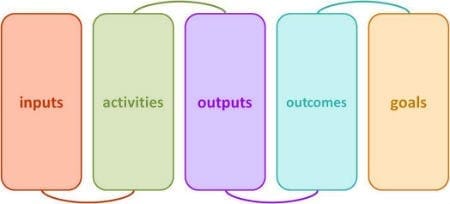Aligning KPIs with the Program Logic Model
by Stacey Barr |Some governments and other organisations not driven by profit use versions of program logic or outcomes models. But just because they use a logic or outcome model, doesn’t mean they automatically get great KPIs.

Program logic models visually map the cause–effect relationships that exist between the inputs, activities, outputs, and outcomes produced by their programs or projects, for specific stakeholders.
Program logic models also provide a framework for assessing the impact achieved by the organisation’s application of resources to its programs. These models are intended for organisations whose impact is social change, such as reducing health problems from smoking, reducing water consumption in times of drought, increasing use of sunscreen to minimise skin cancer incidence, or reducing homelessness.
The input-activity-output-outcome thinking that program logic frameworks encourage is very helpful in keeping performance measures focused on what matters, and I would suggest this thinking is useful beyond just social change organisations.
But most of the program logic literature focuses on how to build a program logic model, not on the nitty-gritty steps to find and implement appropriate performance measures to evidence the progress and impact at each stage in the cause-effect flow from inputs to outcomes.
Performance measurement methodologies, like PuMP, can help us design measures for anything, as long as we can articulate the results we want to measure, clearly and specifically. For the Program Logic Model, results are articulated at each stage in the cause-effect chain, from inputs to outcomes.
So once we’ve built our Program Logic Model, we can use a measurement methodology to create meaningful measures for it. Take this example of a Program Logic Model for reducing water consumption in a community:

So, a good measurement methodology can dovetail into any kind of outcomes model – be it for a program, a service, a project, a business process, a product, or a strategy – at the point where that model articulates the results that matter.
DISCUSSION:
Do you use some kind of outcomes or logic model in your organisation? How have you handled the measurement of it?
Connect with Stacey
Haven’t found what you’re looking for? Want more information? Fill out the form below and I’ll get in touch with you as soon as possible.
167 Eagle Street,
Brisbane Qld 4000,
Australia
ACN: 129953635
Director: Stacey Barr




